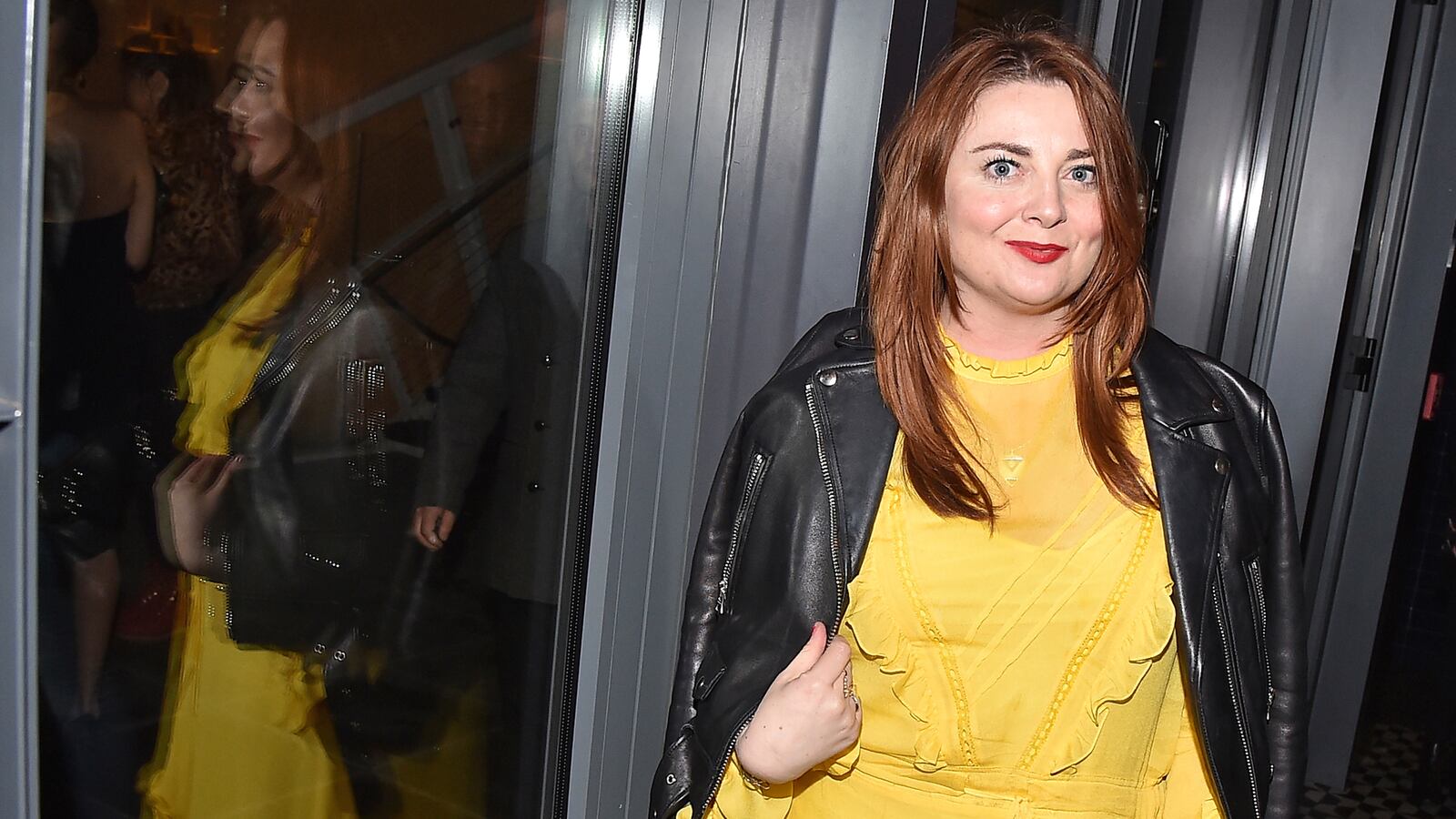The whispering and raised eyebrows commenced almost immediately after Condé Nast revealed in January that the successor to longtime Glamour editor Cindi Leive, who’d presided over the iconic title for 16 years before resigning last September, would be a 36-year-old CNN social and emerging media producer with zero print magazine experience.
The velocity of that tongue-wagging seems only to have increased in glossy mag and luxury brand circles, along with a certain amount of positive fanfare, with the appearance this week of Glamour’s May 2018 issue, Samantha Barry’s first rendering of the 78-year-old mag.
Once the crown jewel and cash cow of the seemingly impregnable Condé Nast empire, Glamour, along with Vanity Fair and the company’s other popular titles, has undergone painful belt-tightening over the past decade amid the often perplexing challenges of the relentless digital onslaught.
Sitting with a fresh copy of her first issue at a lustrous white-marble oval table—and proudly showing off a cell-phone video of the magazine streaming off the presses in Kentucky (the print magazine boasts a circulation of 2.3 million)—Barry was modeling a casual ensemble: a pink Alice and Olivia duster jacket over a white Club Monaco blouse, distressed J. Crew jeans, and shimmering gold Steve Madden brogues.
Her necklace—a gift from a friend and fellow Irishwoman, jewelry designer Laura Whitmore—sported a pendant in the shape of a guitar pick engraved with the encouraging words “You’re lovely.”
Yet for Glamour’s freshly minted editor in chief, the notoriously judgmental (some might say bitchy) Condé Nast culture—mythologized in The Devil Wears Prada, the 2006 movie starring Meryl Streep as an Anna Wintour stand-in—is a day at the beach compared to what she has already experienced as a globe-trotting broadcast and web journalist.
There was that moment several years ago in the Kurdish city of Erbil, Iraq—where Barry, then at the BBC, was taking part in a U.S. State Department “soft power” program for international reporters—when a massive bomb exploded a block from their hotel.
“The State Department told us that we couldn’t leave the hotel for the next five days,” Barry recalled in a cadence that mixes the haste of a harried Manhattan media boss with the countrified inflections of her native land. “The guys in the hotel slipped a note under our doors saying we know you’re stuck here so we’re never going to shut the bar…We ended up cleaning them out of all their whiskey and gin.”
A few years before that, circa 2009, Barry was driving her company Jeep through Papua New Guinea’s capital of Port Moresby, where she was doing an 18-month stint as a correspondent for the Australian Broadcasting Corporation, when gun-wielding thugs surrounded her vehicle and staged a carjack.
“It was scary,” Barry told me. “It was six guys; they pulled me out of my car and one of them put a sawed-off gun to my head three times. I think he was on one of the local drugs.”
Having recently taken a “hostile environment training” course, Barry remembered to acknowledge her situation to herself and stay outwardly calm, and quickly surrendered her car keys, cell phone, and anything else her attackers wanted; in due course they focused on their snazzy new ride and let her wander away. Afterward she went into therapy for a case of post-traumatic stress disorder.
“I couldn’t watch Bruce Willis movies for awhile,” she confided.
Barry, who is charming and down to earth in ways that explode the caricature of the waspy Condé Nast editrix, also admitted to another vulnerability that is often stigmatized at the top of the corporate ziggurat.
“I’m a crier,” she confessed. “I’m not crying every day. But here’s the thing. I don’t think people should be ashamed of that”—i.e., crying at the office. “They are so invested in their job they get frustrated, which is usually why I cry. And I’ve cried over every job I’ve left. I shed a lot of tears leaving CNN, and a lot of tears leaving the BBC…I haven’t cried here—yet.”
Through her travels around the planet, Barry has gotten to know a great many people—including former Vermont governor Howard Dean, who met her during a National Democratic Institute trip to Myanmar and invited her in 2015 to help him teach a foreign policy class at Yale University’s Jackson Institute for Global Affairs.
“She’s an amazing person—a huge gem and a huge coup for Condé Nast,” Dean told The Daily Beast, adding that Barry is “a good friend” and they have discussed her new job in detail. “She got hired because Glamour needs not just a face lift but a mission lift…It’s a huge gamble, but if you don’t take gambles when you’re going in the wrong direction then you don’t get better.”
It should be obvious by now that Barry, who grew up with a brother and sister under very modest circumstances in the County Cork village of Ballincollig—and devoured unsold back issues of U.K. Glamour and Vanity Fair, offered for free, albeit with their covers torn off, at the local news agents’—is a world-class networker.
She first met the real Anna Wintour—and somehow won her heart–at the celebrity-packed 2014 Venice wedding of George Clooney and Amal Alamuddin; it turns out Barry is a close friend of the bride, having bonded with the London human rights lawyer (over, among other things, their mutual love of going out dancing) at a glittering dinner party years earlier at the exclusively private 5 Hertford Street club.
Wintour was one of the first people Barry contacted when she moved to Manhattan more than four years ago for the CNN job. When the Glamour job came open last year, Wintour, the legendary Vogue editor and Condé Nast artistic director, was among those who encouraged Barry to apply.
"When I interviewed Sam, it became apparent that she had been preparing for this job her entire life,” Wintour said in a statement to The Daily Beast. “Her experience working in more than 25 countries, reporting and training journalists in broadcasting, technology, and social media made it clear she was ready to take on Glamour at a time of such seismic change in our culture.”
Wintour added: “Good and true journalism is imperative at a time when values are shifting and changing so radically. Sam brings a vision for Glamour that is fun, inclusive, deeply thoughtful, unpredictable, and fearless. I can’t tell you how excited we are to watch her Glamour unfold, and to see how it will surprise, delight and make waves as it sails forth into the world."
Barry might be a workplace crier, yet one of her first acts as editor in chief—executed, she said, after advice from Leive on which staffers could best help steer the mag into the future—was to lay off half a dozen Glamour veterans (on the same day that Graydon Carter’s successor at Vanity Fair, Radhika Jones, was also swinging the bloody axe).
For her inaugural issue—with plus-size movie star Melissa McCarthy gracing the cover of the “#the money issue,” a cover also plastered with unexpected teases for a woman’s mag like “Meet The New Leaders of Crypto-Currency”—Barry took the radical, high-risk step of trashing Glamour’s familiar san-serif logo and replacing it with something completely different: A bold, Old Hollywood-style declaration of her rowdy entrance onto the glossy mag scene.
“I possibly could do incremental changes, but I felt like it would be 18 months before anybody saw significant change,” Barry told me in her sleek white-décor office on the 30th floor of One World Trade Center, affording a breathtaking view of New York Harbor. “I’m very much a ‘run’ rather than ‘walk’ kind of person.”
Barry conceded that she’s climbing a steep learning curve, “but I’m a fast learner,” she insisted.
Barry said that shortly after she arrived, The New Yorker’s editor in chief, David Remnick, took her to lunch in the Condé Nast cafeteria and explained that she must get used to the idea of making all the big decisions herself instead of looking to others to weigh in.
She began to feel like real magazine editor, she said, when the presses for the May issue had just started running, and managing editor Erin Hobday urgently informed her that there was a glitch in one of the ads that required a fix.
“What do you need me to say? Stop the presses?” Barry recounted her question to Hobday, who answered in the affirmative.
“Stop the presses!” Barry said she shouted.
“That was an amazing moment.”
Barry’s mission—which Leive, for one, was finding ever more elusive by the time of her departure—is to figure out how to make Glamour not only reliably profitable on multiple platforms—print, digital and video, for starters—but also to live up to the new motto Barry has placed in italics above the logo: “Authentic. Accessible. Relevant.”
Barry—who was raised Catholic and now calls herself an atheist—said she has ambitions to cover the 2018 midterm elections from a bipartisan point of view, among other seriously journalistic topics, and “when it comes to fashion and beauty,” she said, “one of things we have to keep in mind is who the Glamour reader is. They’re women across the country, not just coastal L.A. and New York women. It’s a big swath of women who engage with us in the middle of the country. We have a lot of Size 14-plus women who engage with us.”
Barry, who oversees an editorial staff of 50 (around 10 more than she managed at CNN), said she has been rapidly integrating Glamour’s dead-tree, digital, social media and video teams, and urging them to be original, not derivative, and “start the conversation rather than follow the conversation.”
Every morning Barry—much like her former boss, CNN Worldwide President Jeff Zucker—presides over a 9 a.m. story meeting and peppers the staff with questions concerning their ideas for print, digital and video presentations that work in concert with one another and, equally crucial, are exclusive to Glamour.
“I always ask the question, ‘What’s the headline?’ in terms of the print focus,” Barry said. “That’s sometimes hard to pin down, and I won’t assign it if they can’t give me a succinct headline.”
An example of story idea that Barry hates: Kim Kardashian is sporting pink hair! On the other hand, she’d be fascinated by an explanation of Kendall Jenner’s ability to move markets by touting a fashion accessory and piece of clothing to her 89 million Instagram followers.
Since her first issue’s theme is money, I asked Barry if it bothered her that Cindi Leive, who took over Glamour in 2000 during a period of relative prosperity, was rumored to be making more than a million dollars—multiples of Barry’s estimated $400,000 salary.
“I think you got that wrong,” she answered. “You can rest assured that I negotiate hard for myself…I’m very satisfied with what I’m making.”
Yet she couldn’t resist adding: “But I also think, to be super-frank, it’s a different era for media wages.”






